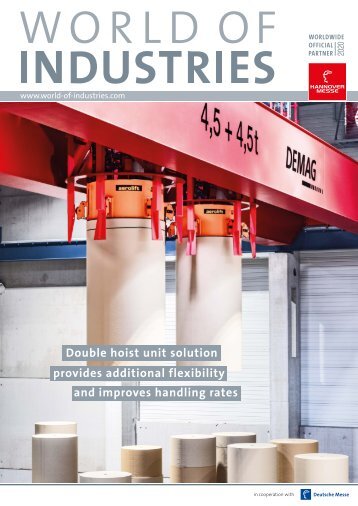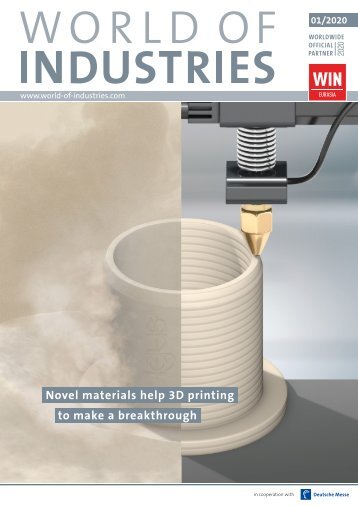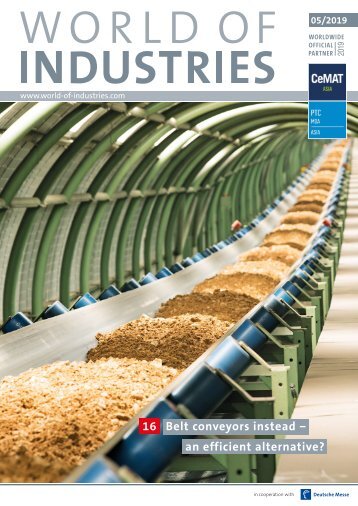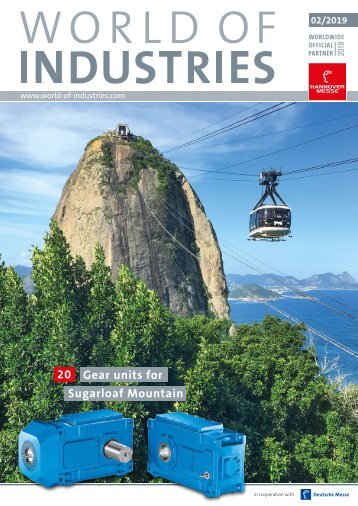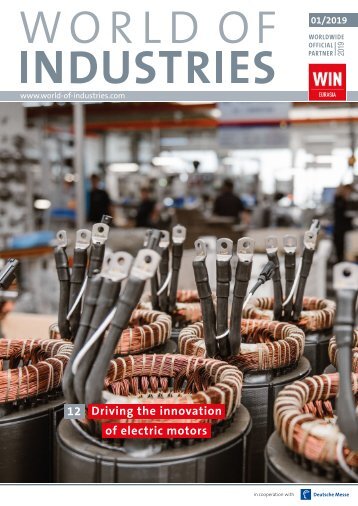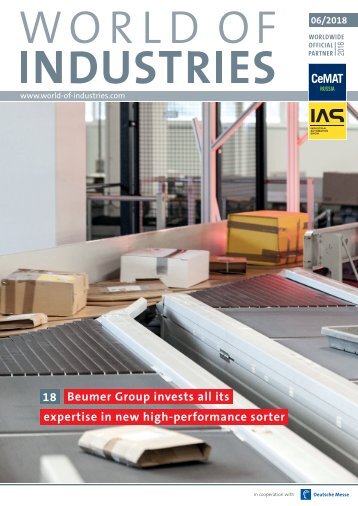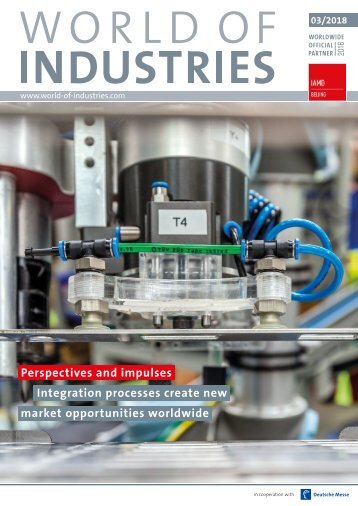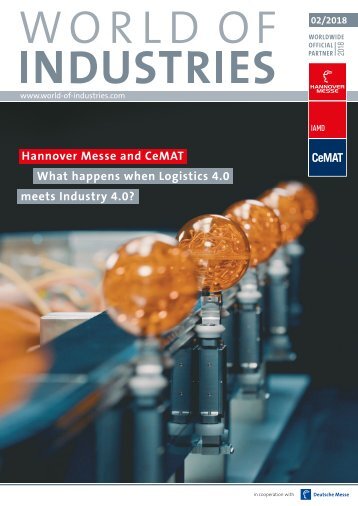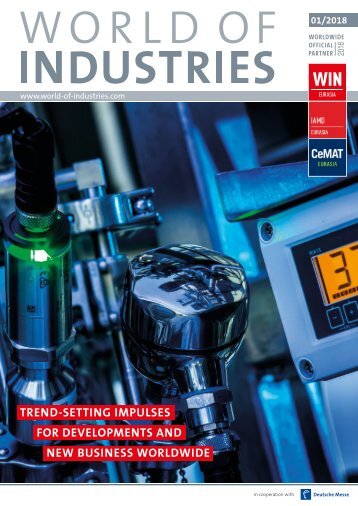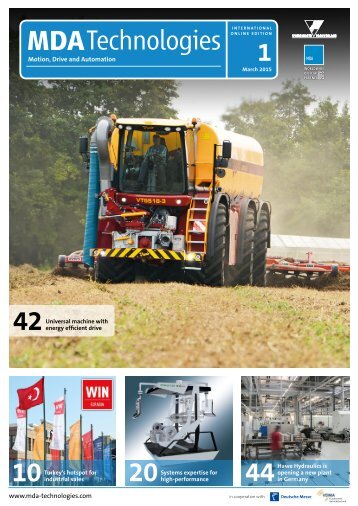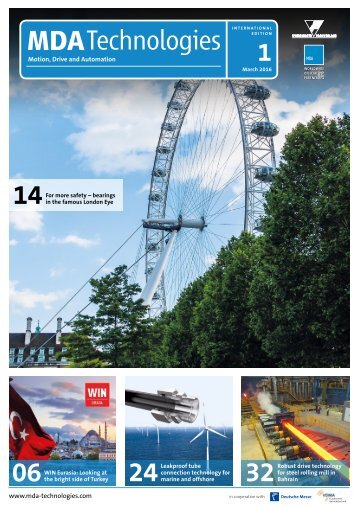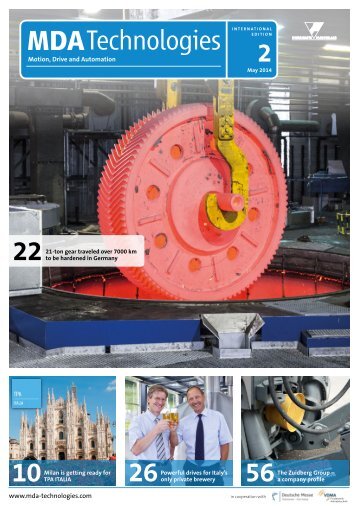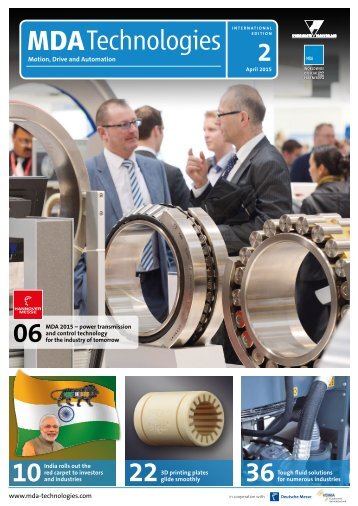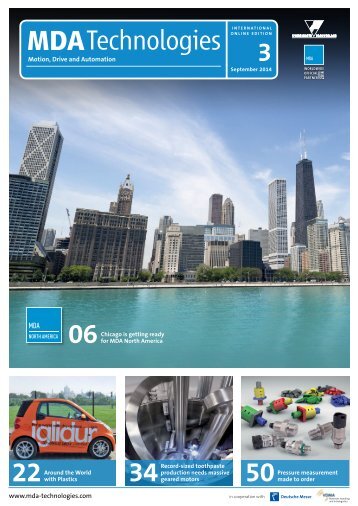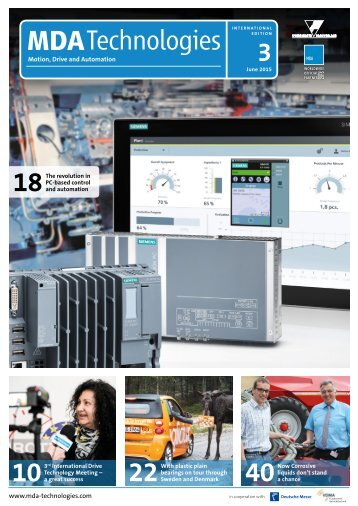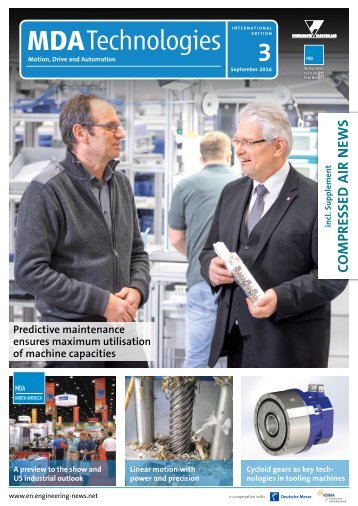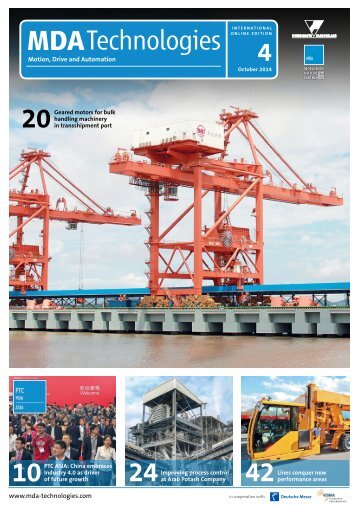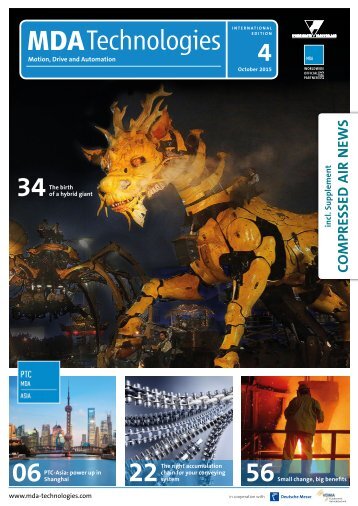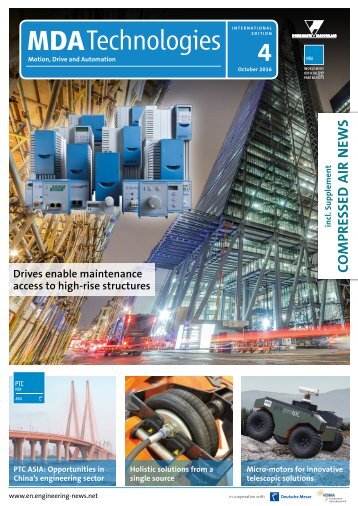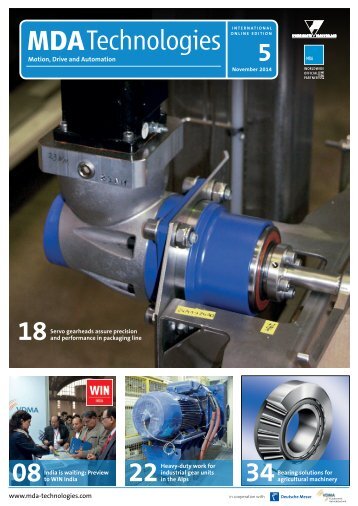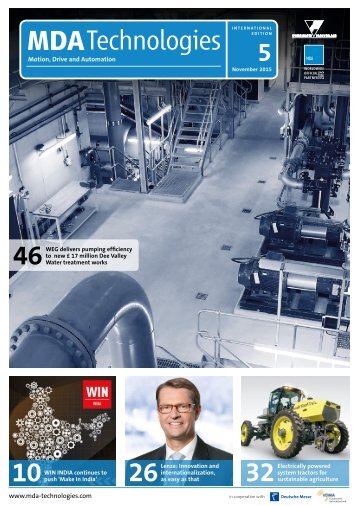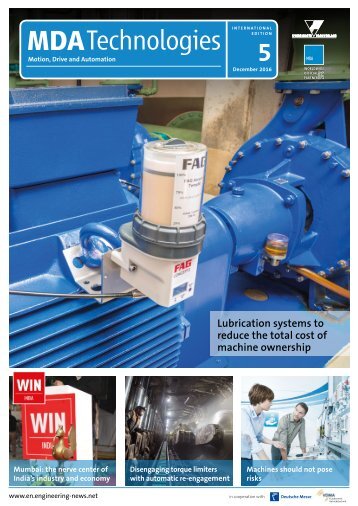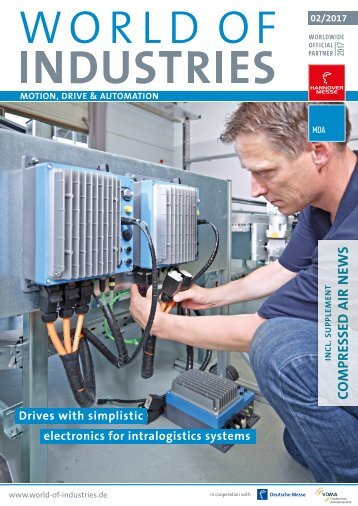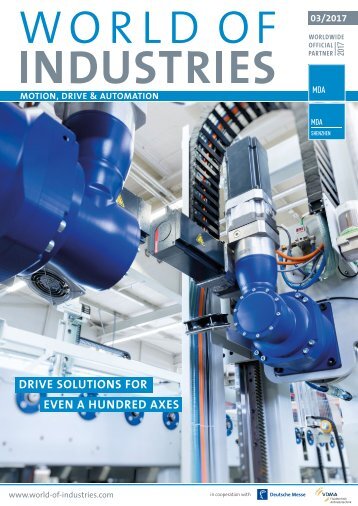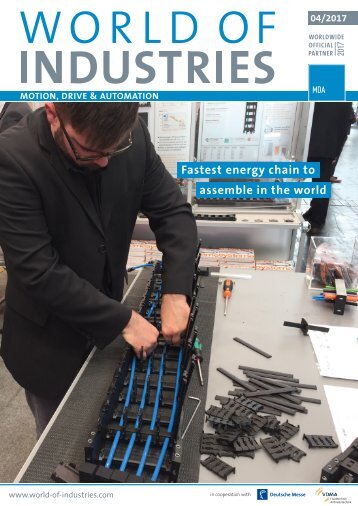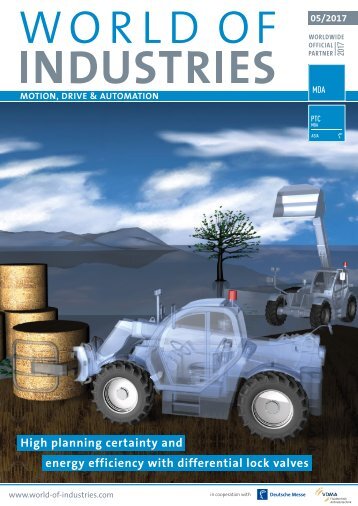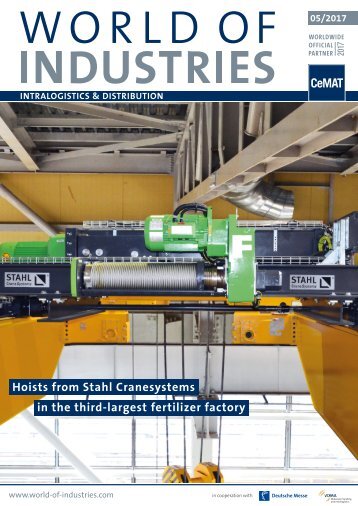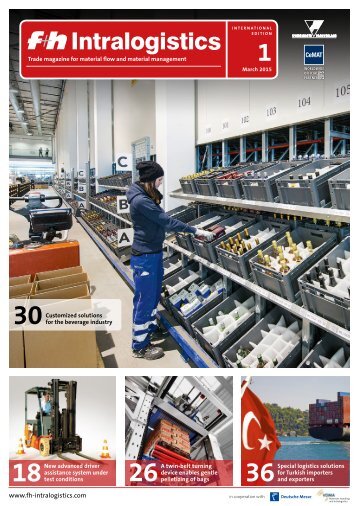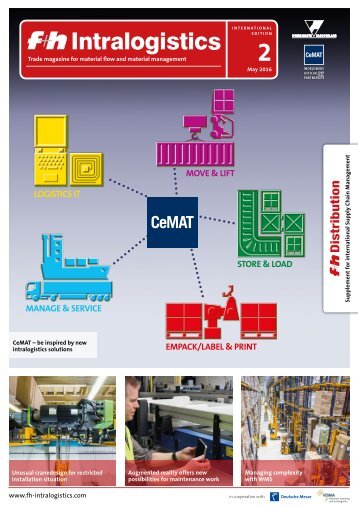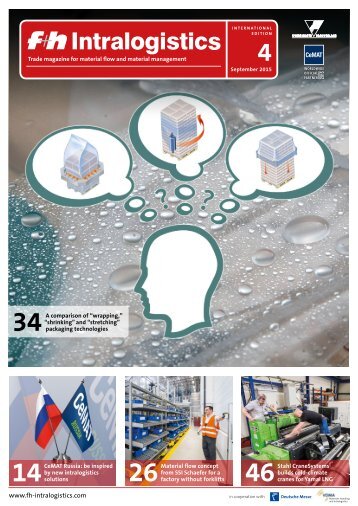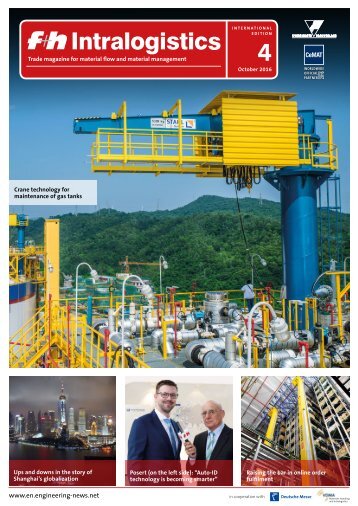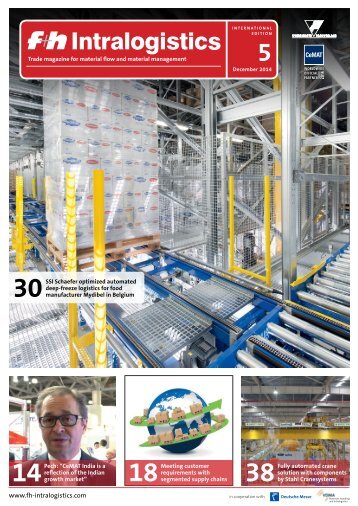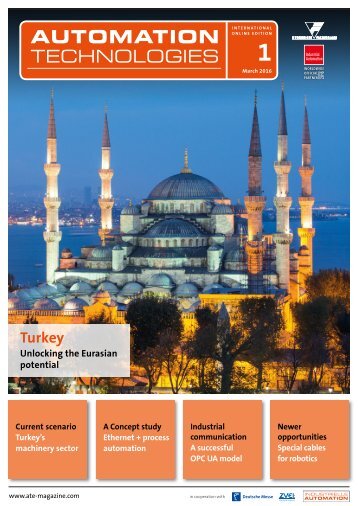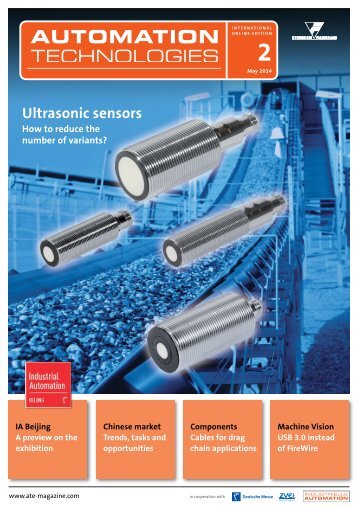MDA Technologies 4/2015
- Text
- Mda
- Technologies
DRIVE TECHNOLOGIES 03
DRIVE TECHNOLOGIES 03 Integrated vane pump on a synchronous motor to set the working pressure between low and no initial flow volume for a period of time. In this state, the pumps heat up because of internal leakage. The smaller the internal leakage of the pump, the longer the dwell time of the pump before a critical temperature is reached in the pump. Once this temperature is reached, the lubrication properties of the hydraulic medium are no longer sufficient to separate the moving parts of the pump, and this results in a mechanical failure. The two most important requirements for variable-speed pumps are the ability to transfer high torques, and low internal leakage. Internal leakage includes not just leakage in the displacement space, but also all other oil flows inside the pump, because such flows also cause losses and, in the case of pressure control, heating of the pump. Adjustable swashplate piston pumps must feed the hydrostatic bearings of the piston shoe and supply the control unit for adjusting the swashplate with pilot oil. These additional oil flows lead to a reduction in the efficiency of the machine, which operates with such low losses in the displacement space. 04 Overall efficiency of the T7B vane pump and internal gear pump of 32 ccm and 50 ccm 46 MDA Technologies 4/2015
DRIVE TECHNOLOGIES The fixed-displacement bent-axis machine has the advantage over the swashplate machine, in variable-speed operation, that the pistons are supported on the bearing by spherical balls. This reduces the supply to the hydrostatic bearings, and because it operates constantly, it has no control unit that needs to be supplied. This machine has very high efficiency. On the other hand, its construction costs are high. Internal leakage mainly depends on the length and height of the sealing gaps of the displacement spaces. In this sense, piston machines have a clear advantage, because a round piston in a round hole can be manufactured with very narrow tolerances. Pistons with a larger diameter and a longer piston stroke create larger displacement volumes. There is a proportional relation between leakage and displacement. Toothed flanks or vanes vary in their suitability for sealing the cross-sectional displacement space, and the side flanks of the gears or vane rotors are also difficult to seal without creating large frictional forces. There is more leakage at these points than with piston machines. Gear pumps, both with external and internal gear teeth, are manufactured with different gear sizes, and the displacement volumes within a construction size are defined by different gear widths. There is a proportional relation between leakage and displacement. In pressure-compensated designs for internal gear pumps, the sealing gap at the tooth tip reduces as pressure increases. This increases volumetric efficiency, but also increases mechanical losses. Vane pumps are manufactured with different rotor diameters, and within a construction size the displacement volumes are defined by the profile of the stroke ring. In this construction type, the lengths of sealing gaps remain almost constant. Internal leakage only varies slightly as a result of the differences in vane stroke size. Thus, the pump with the largest displacement volumes, which has the largest vane stroke, has almost the same internal leakage as the pump with the smallest. There is a proportional relation between leakage and displacement volumes across the range, but this declines within a given construction size, thus increasing the efficiency. The most effective combinations are almost as good as the most effective internal gear pumps (Figure 4). The lengths of sealing gaps are roughly the same in internal gear and vane pumps, and thus both types of pumps exhibit very similar leakage rates up to medium pressures. In terms of energy efficiency of the system, efficiency is crucial at high rotation speeds and pressures, because this is where the most energy is used. At small rotation speeds, efficiency is important for the pump itself, because in pressure-holding operation the pump is barely able to dissipate heat. In the absence of flow, only internal leaking is pumped. The T7E15 pump is of the same construction size as the T7E10, but has the largest vane stroke and hence is better in terms of efficiency. At identical displacement volumes, the pump has to turn faster the greater the leakage is. Internal gear and vane pumps are equivalent; at higher pressures, the vane pump has to turn somewhat faster (Figure 5). Because this heat cannot be dissipated without a drain port (which is normally dispreferred with fixed-displacement pumps in order to simplify installation), the maximum pressure-holding time up to the heating limit is a function of leakage. A higher level of leakage means a shorter pressureholding time in the absence of flow. However, a higher level of leakage also entails a higher rotation speed and thus a lower pressure pulsation. If the pressure-holding time that can be achieved is not sufficient for the application, a small amount of flow to eliminate the dissipation loss of the pump will extend this time considerably. For the most part, leakage will provide sufficient flow for the connected device to achieve sufficiently long pressure-holding times for the application (Figure 6). Compact und robust The trend towards variable flow rates is forcing manufacturers of fixed-displacement pumps to adapt their products for variablespeed operation. In the future, a wider range of designs is to be expected on the market. A variable-flow vane pump is already available as an additional option alongside more established products. This pump is quieter than a piston machine and has a considerably simpler design. The vane pump is comparable in terms of hydraulic efficiency and noise characteristics, and, at medium pressure at no flow condition, it has almost the same pressure-holding times as an internal gear pump. With respect to the pressure-holding times of fixed-displacement pumps in general, it should be noted that, in practice, the need for pilot oil and the leakages of the components of the total hydraulic system, impose no restrictions. The vane pump is the only pump that can run on the extended shaft of the electric motor, which makes this integrated solution uniquely compact and robust. Photographs: Parker Hannifin 05 Comparison of rotation speeds in pressure-holding operation depending on volume of efficiency of a vane pump and an internal gear pump of 31.8 ccm 06 Pressure-holding time (T ≤ 90 °C, HLP32) of a vane pump of 50 ccm depending on volume of efficiency Bibliography: [1] H. Murrenhoff, Grundlagen der Fluidtechnik, Band 1: Hydraulik, 6. Auflage, 2011 [2] R. Bublitz, K. Roosen, Energetic optimization of variable speed pump systems, 9. Internationales Fluidtechnisches Kolloquium, Aachen, 2014 [3] T. Neubert, J. Wolff, S. Helduser, H. Spath, Untersuchung elektrischer Antriebssysteme am Beispiel von Hydraulikpumpen; Antriebstechnik 43 Nr. 1, 2004 [4] I. Rühlicke, Elektrohydraulische Antriebssysteme mit drehzahlveränderbarer Pumpe, Dissertation, Technische Universität Dresden, 1997 www.parker.com About Company name: Parker Hannifin GmbH & Co. KG Headquarters: Cleveland, OH, USA Turnover: $ 13 bn Established: 1918 Employees: 57,500 worldwide Products: pumps, fittings, adapters, valves, flanges, sensor control MDA Technologies 4/2015 47
- Page 1: Motion, Drive and Automation INTERN
- Page 4 and 5: TABLE OF CONTENT 08 Shanghai in foc
- Page 6 and 7: NEWS AND MARKETS PTC-Asia power up
- Page 8 and 9: NEWS AND MARKETS Shanghai in focus
- Page 10 and 11: NEWS AND MARKETS Iran deal, a new c
- Page 12 and 13: NEWS AND MARKETS Hannover - the hid
- Page 14 and 15: NEWS AND MARKETS Bolenz & Schäfer
- Page 16 and 17: NEWS AND MARKETS Paving the way to
- Page 18 and 19: Antriebstechnik Worldwide News Subs
- Page 20 and 21: Rapid prototyping guided by “igus
- Page 22 and 23: MACHINE ELEMENTS The right accumula
- Page 24 and 25: MACHINE ELEMENTS Bearing solutions
- Page 26 and 27: MACHINE ELEMENTS 03 04 04 The CABA3
- Page 28 and 29: MACHINE ELEMENTS Powerhouses on tou
- Page 30 and 31: MACHINE ELEMENTS 01 The dynamic-lif
- Page 32 and 33: Product News Decentralized supply m
- Page 34 and 35: ANTRIEBE UND ANTRIEBSELEMENTE I HYB
- Page 36 and 37: DRIVE TECHNOLOGIES 02 Visual PowerP
- Page 38 and 39: MACHINE ELEMENTS A cut above the re
- Page 40 and 41: A valve for every scenario Ulrike B
- Page 42 and 43: MEASUREMENT AND CONTROL 02 Proporti
- Page 44 and 45: New option: variable flow vane pump
- Page 48 and 49: MEASUREMENT AND CONTROL Telematics
- Page 50 and 51: SCHLUSSLICHT I SERIE MEASUREMENT AN
- Page 52 and 53: A good braking system accelerates g
- Page 54 and 55: SUCCESS STORY 01 The high-performan
- Page 56 and 57: Small change, big benefits Christop
- Page 58 and 59: SUCCESS STORY Company name: R+W Ant
- Page 60 and 61: COMPRESSED AIR NEWS COMVAC ASIA Com
- Page 62 and 63: 01 Authors: Dipl.-Ing. (FH) Erwin R
- Page 64 and 65: COMPRESSED AIR NEWS COMVAC ASIA sol
- Page 66 and 67: Product News Gas compressors for ex
- Page 68: 68 MDA Technologies 4/2015
Inappropriate
Loading...
Mail this publication
Loading...
Embed
Loading...




